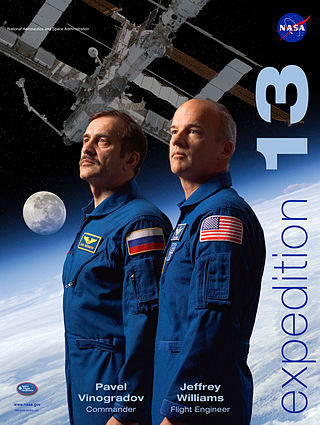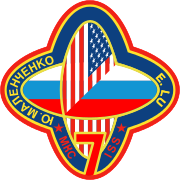
Soyuz TMA-2 was a Soyuz mission to the International Space Station (ISS) launched by a Soyuz FG launch vehicle. The spacecraft docked with the ISS on April 28, 2003 and undocked on October 28, 2003. Soyuz TMA-2 was the second flight for the TMA modification of the Soyuz spacecraft, and the 6th Soyuz to fly to the ISS.

Yuri Ivanovich Malenchenko is a retired Russian cosmonaut. Malenchenko became the first person to marry in space, on 10 August 2003, when he married Ekaterina Dmitrieva, who was in Texas, while he was 240 miles (390 km) over New Zealand, on the International Space Station. As of December 2023, Malenchenko ranks third for career time in space due to his time on both Mir and the International Space Station (ISS). He is a former commander of the International Space Station.

Yury Valentinovich Lonchakov is a Russian former cosmonaut and a veteran of three space missions. He has spent 200 days in space and has conducted two spacewalks. From 2014 to 2017, Lonchakov served as head of the Yuri Gagarin Cosmonaut Training Center.

STS-106 was a 2000 Space Shuttle mission to the International Space Station (ISS) flown by Space Shuttle Atlantis.

Gennady Ivanovich Padalka is a Russian Air Force officer and Roscosmos cosmonaut. Padalka held the world record for the most time spent in space at 878 days until Oleg Kononenko broke this record on February 4, 2024 at 07:30:08 UTC and is currently at 2nd position. He worked on both Mir and the International Space Station.

Mikhail Vladislavovich Tyurin is a former Russian cosmonaut who flew several missions to the International Space Station and completed four spacewalks during his career. He was awarded the title Hero of the Russian Federation for his work as a cosmonaut.

Yury Vladimirovich Usachov is a former cosmonaut who resides in Star City, Moscow. Usachov is a veteran of four spaceflights, including two long-duration missions on board the Mir Space Station and another on board the International Space Station. During his career, he also conducted seven spacewalks before his retirement on April 5, 2004.

Fyodor Nikolayevich Yurchikhin is a Russian cosmonaut of Pontic Greek descent, engineer and RSC Energia test-pilot who has flown on five spaceflights. His first spaceflight was a 10-day Space Shuttle mission STS-112. His second was a long-duration stay aboard the International Space Station (ISS) as a flight engineer for Expedition 15; for this mission he was launched in the Soyuz TMA-10 spacecraft. He has undertaken two further long-duration stays aboard the ISS, as a crew member of Expedition 24 / 25. For this mission he was launched with the spacecraft Soyuz TMA-19, and he landed in November 2010, also with the Soyuz TMA-19 spacecraft. He served as Soyuz commander for his fourth mission aboard Soyuz TMA-09M, as flight engineer for Expedition 36 and ISS commander for Expedition 37. In April 2017, Yurchikhin launched on Soyuz MS-04 for the fifth spaceflight of his career, a six-month mission to the ISS as part of Expedition 51 and 52, for which he was the commander.

Expedition 9 (2004) was the ninth expedition to the International Space Station.

Expedition 8 was the eighth expedition to the International Space Station.

Expedition 11 (2005) was the 11th expedition to the International Space Station, using the Soyuz TMA-6, which stayed during the expedition for emergency evacuation.

Expedition 13 was the 13th expedition to the International Space Station (ISS), and launched at 02:30 UTC on 30 March 2006. The expedition used the Soyuz TMA-8 spacecraft, which stayed at the station for the duration of the expedition for emergency evacuation.

Expedition 14 was the 14th expedition to the International Space Station (ISS). Commander Michael López-Alegría, and flight engineer Mikhail Tyurin launched from Baikonur Cosmodrome on 18 September 2006, 04:09 UTC, aboard Soyuz TMA-9. They joined Thomas Reiter, who had arrived at the ISS on 6 July 2006 aboard Space Shuttle Discovery during mission STS-121. In December 2006, Discovery mission STS-116 brought Sunita Williams to replace Reiter as the third member of Expedition 14. On 21 April 2007, López-Alegría and Tyurin returned to Earth aboard TMA-9. Landing occurred at 12:31:30 UTC.

Expedition 15 was the 15th expedition to the International Space Station (ISS). Four crew members participated in the expedition, although for most of the expedition's duration only three were on the station at any one time. During Expedition 15, the ISS Integrated Truss Structure was expanded twice: STS-117 brought the S3/S4 truss, and STS-118 brought the S5 truss.

Akihiko Hoshide is a Japanese engineer, JAXA astronaut, and former commander of the International Space Station. On August 30, 2012, Hoshide became the third Japanese astronaut to walk in space.

Expedition 16 was the 16th expedition to the International Space Station (ISS). The first two crew members, Yuri Malenchenko and Peggy Whitson, launched on 10 October 2007, aboard Soyuz TMA-11, and were joined by spaceflight participant Sheikh Muszaphar Shukor, the first Malaysian in space.

Sergey Aleksandrovich Volkov is a retired Russian cosmonaut and engineer. He was a member of three missions to the International Space Station, spending more than a year in total in space. During his missions he did four spacewalks lasting more than 23 hours in total. Volkov retired from the Cosmonaut group in February 2017.

Expedition 18 was the 18th permanent crew of the International Space Station (ISS). The first two crew members, Michael Fincke, and Yuri Lonchakov were launched on 12 October 2008, aboard Soyuz TMA-13. With them was astronaut Sandra Magnus, who joined the Expedition 18 crew after launching on STS-126 and remained until departing on STS-119 on 25 March 2009. She was replaced by JAXA astronaut Koichi Wakata, who arrived at the ISS on STS-119 on 17 March 2009. Gregory Chamitoff, who joined Expedition 18 after Expedition 17 left the station, ended his stay aboard ISS and returned to Earth with the STS-126 crew.

Poisk , also known as the Mini-Research Module 2, is a docking module of the International Space Station (ISS). Added in 2009, Poisk was the first major Russian addition to the International Space Station since 2001. Poisk is overall the same design as the docking module Pirs. Whereas Pirs was attached to the nadir ("bottom") port of Zvezda, Poisk is attached to the zenith ("top"); Pirs was closer to the Earth with the ISS in its usual orientation, and Poisk is on the other side. Poisk is Russian for explore or search. Poisk combines various docking, EVA, and science capabilities. It has two egress hatches for EVAs in addition to the two spacecraft docking ports. Although Poisk is designated as Mini-Research Module 2, it arrived before Mini-Research Module 1 (Rassvet), which had a different design; Poisk looks more like the Pirs docking port, which is not designated as a mini-research module.

Expedition 28 was the 28th long-duration expedition to the International Space Station, and began on 23 May 2011 with the departure of the members of Expedition 27. The first three members of Expedition 28 arrived on the ISS aboard the Soyuz TMA-21 spacecraft on 4 April 2011, and were joined on 9 June 2011 by the three other crew members, who arrived aboard Soyuz TMA-02M. The expedition saw a number of significant events, including the final Space Shuttle mission, STS-135, which took place in July 2011. Expedition 28 was superseded by Expedition 29 on 16 September 2011.

























